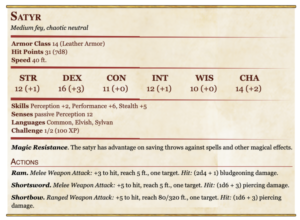The Satyr is one of the first non-humanoid playable races. Satyrs are fascinating mythological creatures, famous in Greek folklore, Shakespeare’s works, and even in extra modern-day works like Chronicles of Narnia. While there’s a bit extra to them, they can greatly be summarized as goat-people fey who love to party.
Beyond that, Dexterity and Charisma is a novel pairing that works for pretty a few builds, and the Satyr’s different characteristics come with a lot of exciting flavors. Satyrs are Fey alternatively than humanoids (this is now not the first occasion of this; centaurs predate satyrs considerably), so you’re immune to spells like Hold Person, however, you may also have greater trouble with spells like Banishment. Mirthful Leaps appears like a bizarre “ribbon” capability with little mechanical impact, however, you can use it to soar over areas that are challenging terrain, permitting you to go about in a fight greater effortlessly in some cases.
Unleash Your Inner Musician with the Satyr Race in D&D 5e
If a satyr has even heard of a holiday, they are certain to rejoice in it with a raucous party. Considering the massive quantity of celebrations and holy days throughout a number of cultures, Satyrs have greater than adequate excuses to indulge in their hedonistic tendencies.

By frolicking, satyrs carry up their cares and free themselves from disturbing the previous or the future. Revelry is how they wholly stay in each current moment. In their eyes, the excellent way to honor the gods is via experiencing all that existence has to provide with all of one’s senses.
Of course, due to the fact Satyrs in D&D 5e is so pushed via intuition and intuition, they are notoriously unpredictable. They nearly by no means reflect on the penalties of their movements and love to carry out the celebration of animals in others. Few matters are extra exciting than roping others into their revelry!
Satyrs in DnD 5e’s Monster Manual are admittedly missing in the description. They are rapidly described as chaotic revelers, although the supplied facts about their pipe skills are very pleasant to have.
It’s very unlikely that Satyrs are going to try to combat the party. They will very probably invite them to be part of their festivities and can also attempt to allure them if the characters decline.

- Armor Class: 14 (Leather Armor)
- Hit Points: 31 (7d8)
- Speed: 40 ft.
- Skills Perception: +2, Performance +6, Stealth +5
- Senses: passive Perception 12
- Languages: Common, Elvish, Sylvan
- Challenge: 1/2 (100 XP)
Satyrs as NPCs
Satyrs can make for interesting NPCs in a D&D 5e campaign, adding a touch of mischief and magic to the story. Here are some ideas for using Satyrs as NPCs:
- The Trickster: Satyrs are known for their love of pranks and tricks, so a Satyr NPC could be a trickster who delights in playing practical jokes on the player characters.
- The Musician: Satyrs are also known for their musical abilities, so a Satyr NPC could be a musician who entertains the player characters with their enchanted melodies. They could also offer information or guidance in exchange for a performance or musical tribute.
- The Druid: Satyrs have a strong connection to nature, which makes them a good fit for the druid class. A Satyr NPC could be a druid who serves as a guardian of the forest or a protector of a natural wonder.
- The Guide: Satyrs are often depicted as wandering creatures who know the woods and fields like the back of their hand. A Satyr NPC could serve as a guide for the player characters, leading them through the wilderness and offering insights into the creatures and dangers they may encounter.
- The Enchanter: Satyrs have a natural affinity for magic, which makes them a good fit for the role of an enchanter or magical advisor. A Satyr NPC could offer spells, enchantments, or magical items to the player characters, but with a price or favor attached.
Satyrs as Monsters
In D&D 5e, Satyrs can also be used as monsters for the player characters to encounter and battle. Here are some ideas for using Satyrs as monsters in your campaign:
- Challenge – 1/2 (100 XP)
- Proficiency Bonus – 2
- Stats – STR 12 (+1), DEX 16 (+3), CON 11 (+0), INT,12 (+1), WIS 10 (+0), CHA 14 (+2)
- Languages – Common, Elvish, Sylvan
- Armor Class – 14
- Speed – 40
- Hit Points – 31 (or 7d8)
- Skills – Perception +2 (passive 12), Performance +6, Stealth +5
Forest Guardians: Satyrs can be used as guardians of the forest or natural places, using their Fey magic to protect the area and ward off intruders.
Tricksters: Satyrs love to play tricks and pranks on others, so they can be used as mischievous monsters that cause chaos and confusion for the player characters.
Enchanters: Satyrs have a natural affinity for magic, so they can be used as powerful enchanters who use their magic to manipulate and control others.
Ambushers: Satyrs are agile and stealthy, making them good ambushers who can strike from hiding places in the woods or fields.
Musical Lures: Satyrs are known for their enchanting music, which can be used as a lure to draw the player characters into danger. The Satyr can play music to distract and charm the player characters, making them easier targets for other monsters or traps.
Corruptors: Satyrs can be used as corruptors who tempt the player characters into making bad decisions or committing evil acts. The Satyr can offer rewards or promises in exchange for the player characters doing their bidding, leading them down a dark path.
Famous Satyrs for Inspiration
In mythology and literature, there are many famous Satyrs that can serve as inspiration for your D&D 5e campaign. Here are a few notable examples:
- Pan: In Greek mythology, Pan is the god of shepherds, flocks, and wild nature. He is often depicted as a Satyr, with the lower body of a goat and the upper body of a man. Pan is known for his mischievous nature and his love of music and dance.
- Silenus: In Greek mythology, Silenus is a companion of Dionysus, the god of wine and revelry. Silenus is often depicted as a drunken old man with a pot belly and a donkey’s ears and tail. He is known for his wise and witty sayings, as well as his love of drinking and carousing.
- Puck: In Shakespeare’s “A Midsummer Night’s Dream,” Puck is a mischievous fairy who delights in playing tricks on humans. He is often depicted as a Satyr, with the horns and legs of a goat. Puck is known for his magical powers and his love of mischief.
- Mr. Tumnus: In C.S. Lewis’s “The Lion, the Witch, and the Wardrobe,” Mr. Tumnus is a kind and gentle Satyr who befriends the main character, Lucy. He is known for his love of tea and his musical abilities.
- Faunus: In Roman mythology, Faunus is the god of the forest and fields. He is often depicted as a Satyr, with the lower body of a goat and the upper body of a man. Faunus is known for his prophetic abilities and his association with fertility and abundance.
Satyr Names
- Satyr Male Names: Apostius, Baucus, Cerbus, Helus, Kratius, Orthrius, Tolus, Zenus
- Satyr Female Names: Adelphia, Baccia, Bastia, Gila, Jasia, Lichia, Loxia, Yoria
- Satyr Nicknames: Bounder, Bristlechin, Clip-Clop, Dappleback, Hopper, Nobblehorn, Orangebeard, Quickfoot, Scrufflebutt, Sunbeam, Skiphoof, Twinkle-Eyes
Satyr Name Ideas
Here are some Satyr name ideas for your D&D 5e character:
- Panlo
- Meliphron
- Syrinx
- Caelus
- Euryalus
- Nysus
- Phaon
- Liriope
- Faunus
- Dryops
- Oenone
- Thalia
- Morpheus
- Iphis
- Hyacinth
- Selenus
- Pythios
- Eurydice
- Lelex
- Antheus
Best Satyr Classes
Satyrs have abilities and traits that make them well-suited for certain classes in D&D 5e. Here are some of the best classes for Satyrs:
- Bard: Satyrs are known for their musical abilities, which makes them a natural fit for the bard class. Their Charisma bonus also helps with their spellcasting and social skills.
- Rogue: Satyrs are agile and dexterous, making them well-suited for the rogue class. Their Fey ancestry trait also gives them an advantage on saving throws against being charmed, which can be useful for a rogue who relies on their wits to get out of tricky situations.
- Druid: Satyrs have a strong connection to nature, which makes them a good fit for the druid class. Their Satyr Magic trait also gives them access to the druid craft cantrip, which can be useful for interacting with the natural world.
- Sorcerer: Satyrs have a natural affinity for magic, which makes them a good fit for the sorcerer class. Their Charisma bonus also helps with their spellcasting abilities.
- Warlock: Satyrs have a mischievous nature, which makes them a good fit for the warlock class. Their Fey ancestry trait also gives them the advantage of saving throws against being frightened, which can be useful for a warlock who relies on their powers to intimidate their foes.
Actions
- Ram: Melee Weapon Attack: +3 to hit, reach 5 ft., one target. Hit 6 (2d4 + 1) bludgeoning damage.
- Shortsword: Melee Weapon Attack: +5 to hit, reach 5 ft., one target. Hit 6 (1 d6 + 3) piercing damage.
- Shortbow: Ranged Weapon Attack: +5 to hit, range 80/320 ft., one target. Hit 6 (1d6 + 3) piercing damage.
Random Height and Weight
| Base Height | Height Modifier | Base Weight | Weight Modifier |
|---|---|---|---|
| 4'6 | +2d8 in | 130lb. | x(2d4)lb. |
Despite solely having a CR of 1/2, Satyrs frequently journey in groups. If compelled to shield themselves, they use their horns to ram enemies or battle with shortswords and bows. One member of a crew of Satyrs can also have panpipes that they can use to allure the players.
Check also: Githyanki 5e
Satyrs are exciting and dynamic creatures. Particularly for lower-level events that are much less in all likelihood to be resistant to their charms, Satyrs can create encounters that are memorable for the players. The characters likely won’t take this into account and may additionally locate themselves with a lousy hangover, however, you understand what they say: you solely stay once.
FAQs
Q1.Understanding the mechanics of a satyr’s Mirthful Leaps trait?
A: You’ve obtained the mechanics right, however, you need to pass with your toes to a long jump
Q2.Is the satyr’s Mirthful Leaps trait affected by means of leap multipliers?
A: Boots of Striding and Springing triple your unmodified soar distance.
Related posts:
Hobgoblin 5e - A Perfect Balance of Brains and Brawn
Deep Gnome 5e – The Life Of The Party
Hellish Heroes: Playing Tiefling as Adventurer in D&D 5e"
Autognome 5e - A Guide to Mechanical Creatures in Spelljammer
A Guide to Playing a Goliath 5e Character - Strength & Resilience
Roleplaying Triton in D&D 5e - Beneath the Waves

Virat Rana is a Blogger from the city of Joy, Kolkata. He is the founder of this blog and covers a wide range of topics from Gadgets to Software to the Latest Offers. You can get in touch with him via [email protected]
